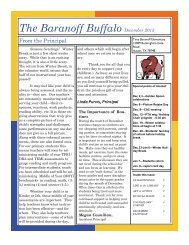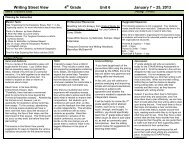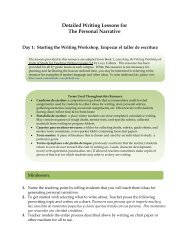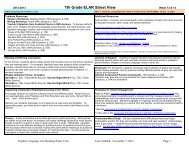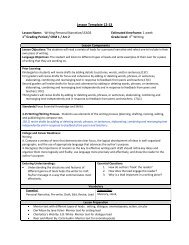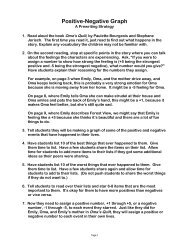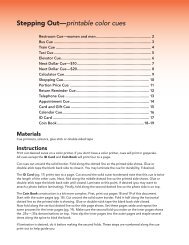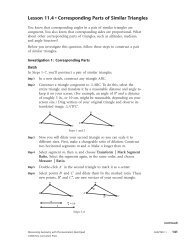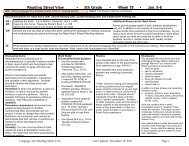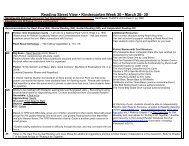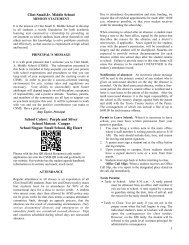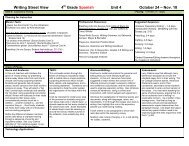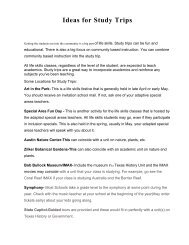Reading Instructional Planning Guide • Kindergarten – Second Grade
Reading Instructional Planning Guide • Kindergarten – Second Grade
Reading Instructional Planning Guide • Kindergarten – Second Grade
- No tags were found...
You also want an ePaper? Increase the reach of your titles
YUMPU automatically turns print PDFs into web optimized ePapers that Google loves.
Arc 1: Understanding Characters in Literary Fiction Texts<strong>Reading</strong> Street View • 4 th <strong>Grade</strong> • Week 1 • August 23 – 27Unit 1: ChangeRecommendations for Read Aloud (RA), Shared <strong>Reading</strong> (SR), <strong>Guide</strong>d <strong>Reading</strong> (GR), and Independent <strong>Reading</strong>RA /SR:GR:Mexico: My New Home (Treas. TE and Treas. Student Book, pgs. 8 – 9) to introduce vocabularyMy Diary from Here to There (Treas. TE and Treas. Student Book, pgs. 10 – 29)During the First 20 days of school you will be putting routines and expectations in place for ReadAloud, Shared <strong>Reading</strong>, and Independent <strong>Reading</strong>. Once those routines are in place, after theFirst 20 days are complete, you will begin pulling small groups for GR. See The First 20 Days.In preparation for GR groups, you may want to consider organizing a GR notebook. Thisnotebook could contain: GR lesson plans by group, GR observation forms, progress monitoringforms, any leveled booklists you may have.Additional Resources for Read Aloud:Other stories with a Change theme:Don’t Need Friends by Carolyn Crimi, Illustrated by LynnMunSingerOne Green Apple by Eve BuntingAmelia’s Road by Linda Jacobs AltmanChapter Books:Because of Winn Dixie by Kate DiCamillo (An excerpt will be usedfor Read Aloud during this unit)Granny Torrelli Makes Soup by Sharon CreechIRTips for Independent <strong>Reading</strong>: This week it will be important to begin putting routines and expectations for independent reading in place. See The First 20 Days.This guide will provide guidance in setting-up a classroom library, in setting up a system for checking out books, and in teaching students how to select a “Just Right”book.Discussing Genre:Over the course of this week you will bereading from a selection of literary fictiontexts. Literary fiction, as defined in theNAEP 2009 <strong>Reading</strong> Framework ischaracterized by the followingcomponents:• the setting or settings;• a simple or complex plot consisting ofa series of episodes and delineating aproblem to be solved;• the problem or conflict, which requirescharacters to change, revise plans, orface challenges as they move towardresolution;• a reaction that expresses theprotagonist’s feelings about his or hergoal attainment or relates to thebroader consequences of theconclusion of the story;• characters populate each story, inmajor or minor roles• themes or major ideas are statedeither implicitly or explicitly.Phonemic Awareness/Phonics/Word Study:Introduce class or personal word wallsthis week. Regie Routman suggestsintroducing word walls by sayingsomething like:On this wall we’re going to displayimportant words that you all need to knowhow to read and write. We’ll decide manyof those words together and talk abouthow and why they’re important as we postthem. Sometimes, I’ll highlight part of aword in color, and that means you canuse that word to help figure out otherwords. Let me show you what I’m talkingabout… Writing Essentials by R.Routman, pg. 165.It’s important that students know from thebeginning of the year that the word wall isa constantly changing resource that theywill actively use and refer to throughoutthe year.Fluency:In order for students to improve theirfluency, they must have direct instructionand feedback in fluency at least threetimes per week. This week you will beginto put routines in place for regular fluencypractice.Vocabulary:Resources:• Mexico: My New Home (Treas. TE,pg. 8 and Treas. Student Book, pg. 8)Vocabulary: opportunities, border,citizen, unions, strikes, boycottsAdditional vocabulary, from text, relatedto Unit on Change: support, rightsRemember to use the Vocabulary Routineoutlined in the TE. For example:Define: If you have opportunities, youhave chances.Example: This year we will have manyopportunities to read and write together.Ask: Would you be happy to have theopportunity to go to a UT basketballgame? What is something you wish youhad the opportunity to do?
Building Comprehension:To help students become active readers, model your own thought processes as youare reading aloud or in a shared setting. Stop and articulate what you are thinking:• The part I just read, really makes me think about what might happen next with______. I’m going to predict that…because… What do you think?• Hmmm, I’m not sure that made sense just now. Let me go back and reread what Ijust read and really think about why the character is acting that way.• I wonder what the author is trying to show us by describing _____ that way? I’mgoing to keep that question in mind as I keep reading.Gradually Releasing the Responsibility: It’s important to always ask students totake on what you have explicitly modeled by inviting them into the conversation duringthe read aloud. Also plan stopping points for comprehension questions that arerelated to character. See The First 20 Days.Suggestions for Pre-Teaching/Applying the ELPS:Resources:• What experiences can cause a person to change?, Treas. Student Book, pg. 4• Treas. Visual Vocabulary Resources, pgs. 1 – 11• English and Spanish Cognates, Treas. TE, pg. 37AAThe unit that begins this week is focused on Change. Choose a short piece of text,such as: What experiences can cause a person to change? to begin the conversationwith your students. Possible questions to pose:• What is change? How do we, as people, change?• What causes us to change? How do we deal with change?• What kind of support do we need when things change for us? How can we supporteach other in our community?Use the Visual Vocabulary Resource, to pre-teach the key vocabulary, phrases, andbasic words for the suggested reading selection to all ELL students in your classroomas well as any other student(s) you think would benefit from these routines.When working with ELL students, always use the ELPS to guide your planning. Alsouse the English/Spanish Cognates on the AISD website.Preparation for Assessment:TAKS Stems for Character Analysis:• ____ is concerned/surprised/curious/startled when ______ because…• Why does ____ want to _____?• How does ______ feel when they first…• How do ______’s thoughts/feelings change after she/he…• How does _____ change in this story?Character Analysis stems that require students to infer:• The reader can tell that ____ enjoys/dislikes/is frustrated by______ because…• From paragraph ___, the reader can tell that _____ was…• Read the following sentence from paragraph 8: “…….” This sentence shows that____ wants to…Academic Language: text, selection, support, evidence, conclude, tell, character,traits, relationships, interactions, motivations, change, internal, externalTopical Essential Questions:In addition to the stopping point questions found in the TE, use questions like these asyou read with students:1. What characters are important in this story? Who is the main character? Who arethe supporting characters?2. What evidence in the text supports your description of_______?3. How did the author reveal or make known the internal traits of the main character?4. How does the main character interact with other characters in the story? How doesthe main character interact with his surroundings or setting? What does this showyou about the character? What can you conclude from those interactions?5. How did the main character change in the story?6. What caused or motivated this character to change? Why is this change importantto the story?Suggestions for Interventions:For students who are struggling to identify character traits and infer about characterbased on the clues from text, consider using role-play in small group and have thestudents describe how they think you are feeling based on your actions, interactions,words, body language, etc… Students could also be given cards with a character trait,such as frustrated, and act that out for the group to describe.Once students are successful with role-play, go back to a previously read text andmake a direct connection to understanding characters in texts based on the author’sclues.Remember to include some of the critical questions (above) in your discussion withstudents.Anchors of Support:Anchors of Support and Graphic Organizers for Character should:• Highlight key terms• Provide a clear example of the thinking processes necessary to understand character• Show how textual evidence supports our understanding of character• Highlight key understandings related to the grade level Knowledge & Skill statementand the Student Expectation, i.e,, in 4 th grade there should be a clear emphasis oncharacter change.• Include question stems related to character analysisOrchestrating <strong>Reading</strong> Success (ORS) Module: Character AnalysisAnchors of Support for Genre should:• List the characteristics of the genre being studied• Have a visual of a strong example of that text type, i.e., Literary Fiction is exemplified byOne Green AppleTeacher Tips: When working with ELL students, always use the ELPS to guide your planning. Also use the English/Spanish Cognates on the AISD website.
Arc 2: Problem and Solution<strong>Reading</strong> Street View • 4 th <strong>Grade</strong> • Week 2 • August 30 – September 3Unit 1: ChangeRecommendations for Read Aloud (RA), Shared <strong>Reading</strong> (SR), <strong>Guide</strong>d <strong>Reading</strong> (GR), and Independent <strong>Reading</strong>RA /SR:GR:IR:<strong>Second</strong> Hand Art (Treas. TE and Treas. Student Book, pgs 370 - 371) to introduce vocabularyMe and Uncle Romie (Treas. TE and Treas. Student Book, pgs. 372-389)During this week you will continue to put routines and expectations in place for Read Aloud,Shared <strong>Reading</strong>, and Independent <strong>Reading</strong>. Students should have time this week to practice theindependent reading routines and you will be able to pull students one at a time to assess themusing the Flynt-Cooter. Remember that the goal is do have all routines in place and all Flynt-Cooter assessments completed by the end of The First 20 Days so that you can begin GR groupsduring Week 5 of school.Additional Resources for Read Aloud:Other stories with a Change theme:Don’t Need Friends by Carolyn Crimi, Illustrated by LynnMunSingerOne Green Apple by Eve BuntingAmelia’s Road by Linda Jacobs AltmanChapter Book:Because of Winn Dixie by Kate DiCamillo (An excerpt will be usedfor Read Aloud during this unit)Granny Torrelli Makes Soup by Sharon CreechTips for Independent <strong>Reading</strong>: This week you will continue to put routines and expectations for independent reading in place. See The First 20 Days. Studentswill practice the independent reading routines this week.Discussing Genre:This week, ask your students to use thedeveloped criteria chart for literary fiction tojudge any books you read aloud.Ask students: Based on our criteria chartfor Literary Fiction, is this book a goodexample of the genre? Why or Why not?Begin a section in your classroom library forliterary fiction. Allow students to add to thissection of the library as they discover otherbooks in your classroom library that meetthe criteria for literary fiction.Building Comprehension:Phonemic Awareness/Phonics/Word Study:This week you will continue to put in placethe class routines for using the class orpersonal word wall. The word wall is meantto be used for the non-negotiable wordsfor your grade level as well as any wordsfrom 1 st – 3 rd grade that they have notmastered - not for vocabulary.Word walls can be valuable resources whenstudents understand how to use them toinvestigate and solve words on their own.Show students how they can do this bymodeling the process for them, for example,“We have the word would on our word wall.This is a word that we can all read andwrite. It can also help us read and write thewords should and could.”The main selection for this week, and many of the additional suggestions, has a series ofconflicts and solutions. These conflicts and solutions are all part of the plot of the story.As you read aloud with students this week, stop and help them to summarize what hasbeen read so far and to identify the challenges the main character is facing as the storydevelops by asking questions like the ones listed in the Critical Questions section.Fluency:Remember that developing oral readingfluency will impact how students readsilently during independent reading.Fountas and Pinnell list – <strong>Reading</strong> with easeso that the greatest amount of attention isfreed to think about the text – as one of theprimary characteristics of fluency and notethat this applies to both oral and silentreading. In The First 20 Days emphasis isplaced on teaching students how to select ajust right book. Putting this in place willensure that students have the opportunity toapply what they have learned during oralfluency practice to their own silentindependent reading.Topical Essential Questions:Vocabulary:Resources:• <strong>Second</strong> Hand Art (Treas. TE, pgs 370 –371 and Treas. Student Book, pgs 370 -371)Vocabulary: skyscrapers, collage,barbeque, glorious, strutting, swarmsUse the suggested text to pre-teachimportant vocabulary that students willencounter in the suggested readings thisweek. Remember to use the VocabularyRoutine outlined in the TE.This would be a good week to introduce a“Word Wonder” wall. This could be a placeto gather interesting words that studentsencounter in books, movies, conversation,etc… The more you model curiosity for andabout words the more students will take thaton too.In addition to the stopping point questions provided in the TE, use these questions as youread with student:1. What has happened so far? Has the author introduced the story problem? How do youknow?2. What is the main problem in this story?
See Recurring TEKS and The First 20 Days.3. Based on what we’ve read so far, how would you predict that this problem will besolved?4. What challenges do the characters encounter and how do they deal with them?5. How are the characters’ actions connected to the problem in the story?6. What events lead up to the solution?Questions related to the Unit: How did the main character feel about his uncle at thebeginning of the story? How did these feelings change? Why did they change?Suggestions for Pre-Teaching/Applying the ELPS:Building background knowledge before jumping into a new text is an important part ofbuilding comprehension. Using the text that you have selected for this week, gather yourELL students and any other student(s) you think would benefit, and take some time tointroduce the big idea and allow students to connect it to their own lives, i.e, Today, we’regoing to read One Green Apple with the whole class. This is a story about a young girl whomoves to a new country and has started going to a new school where she doesn’t speakthe language. Have you ever faced this kind of problem?To pre-teach critical vocabulary using the Treas. Visual Vocabulary Resources, pgs. 13 - 23to pre-teach the key vocabulary, phrases, and basic words for the suggested readingselection to all ELL students in your classroom as well as any other student(s) you thinkwould benefit from these routines.English and Spanish cognates: Treas. TE, pg. 65AAWhen working with ELL students, always use the ELPS to guide your planning. Alsouse the English/Spanish Cognates on the AISD website.These questions should be shared with your reading specialist.Suggestions for Interventions:Some students may have difficulty seeing how multiple events are all connected to theultimate solution in a story. Work with these students in small group to give them aconcrete example of this that they then apply to their understanding of text. You mightconsider using a problem from your classroom, for example:Problem: At the end of every day, our classroom library is completely messy.Events that may or may not be connected to the ultimate solution and in no particular order:• Students made clear labels for the different genres• Teacher called a class meeting• Class went to the school library to get ideas• Everyone went to lunch and recess• Whole class agreed to organize library by genres• One person per week will be assigned to straightening up the library for 5 minutes eachday• Teacher assigned 10 math problems for homework.Preparation for Assessment:TAKS Stems:• ______ main problem is that…• What is a problem that ______ has at the beginning of the story?• Read the diagram of information from the story to answer the next question.Which of the following should go in the empty box?Stems related to plot:• Why is it important to know that…• Paragraph ___ is important to the story because it –• ______ does ______ because…Academic Language: text, evidence, problem, solution, conflict, resolution, plot, events,actionsSolution: A system for keeping the library organizedAsk students to categorize the events into those events that help the class solve their problem andthose that did not. Once they successfully categorized they can put the events in order to illustratehow each event led to the next and ultimately lead to an organized library.Anchors of Support:Anchors of Support and Graphic Organizers for Problem and Solution should:• Highlight key terms (problem/conflict, solution/resolution, events, plot)• Show how textual evidence supports our understanding of problem and solution• Show that literary fiction is characterized by a problem and solution• Highlight key understandings related to the grade level Knowledge & Skill statementand the Student Expectation, i.e,, in 4 th grade there should be a clear emphasis multipleconflicts and solutions in one story.• Show how multiple events can lead up to the solution in a story.• Include question stems related to problem/solutionAnchors of Support for Genre should:• List the characteristics of the genre being studied• Have a visual of a strong example of that genre that has been read aloud in classTeacher Tips: The suggestion for intervention this week includes an example problem that you may be experiencing in your classroom. Maintaining an organized classroom library canbe a challenge, but it is well worth the investment in time and energy for both you and your students. The more students are able to be a part of organizing and maintaining the library thegreater sense of ownership they’ll have. They’ll be more likely to want to keep it organized and visit it often to look for their next great book.
Arc 3: Sequence and Cause & Effect<strong>Reading</strong> Street View • 4 th <strong>Grade</strong> • Week 3 • September 6 – September 10Unit 1: ChangeRecommendations for Read Aloud (RA), Shared <strong>Reading</strong> (SR), <strong>Guide</strong>d <strong>Reading</strong> (GR), and Independent <strong>Reading</strong>RA /SR:GR:IR:A Library Card for Emilio (Treas. Student Book, pgs 106-107) to introduce vocabularyBecause of Winn Dixie (Treas. Student Book, pgs. 109-119)As you continue to assess your students with the Flynt-Cooter, begin to consider how you will groupyour students for GR beginning Week 5. You will want to take several variables into consideration:• Based on the Flynt-Cooter are students below, on, or above grade level?• What is their fluency?• What level of comprehension have they demonstrated during whole group discussion and intheir reading response journal?• How did they do on the <strong>Reading</strong> TAKS test last year?• Are they ELL students who are ready to transition from Spanish to English?Additional Resources for Read Aloud:Other stories with a Change theme:Don’t Need Friends by Carolyn Crimi, Illustrated by Lynn MunSingerOne Green Apple by Eve BuntingAmelia’s Road by Linda Jacobs AltmanChapter Book:Because of Winn Dixie by Kate DiCamillo (An excerpt will be used forRead Aloud during this unit)Granny Torrelli Makes Soup by Sharon CreechTips for Independent <strong>Reading</strong>: At this point in the year, 4 th grade students should be capable of reading independently for at least 30 minutes. As you build the routines andexpectations with your students for independent reading, set goal times with them and carefully lay out what that time should look like and sound like in your classroom. A solidunderstanding of these expectations is what will allow you to successfully begin meeting with your GR groups in 2 weeks.Discussing Genre:Phonemic Awareness/Phonics/Fluency:Vocabulary:This week’s main selection, Because ofWinn Dixie, will give you an opportunity tointroduce a specific genre within literaryfiction. This text is an example of literaryfiction written in the style of a memoir.Elements of a Memoir:• Focuses on a brief period of time or aseries of related events• Narrative structure (setting, plot,conflict, character, etc…) May or maynot be written in 1 st person.• High emotional level• A very personal reconstruction of theevents – always intimately connected tothe memoirist/writer• The writer contemplates the meaning ofthese events and is reflective in theirwriting. Usually ends with a “lessonlearned.”There is wide spread agreement that"Memoirs can never be wholly true, sincethey cannot include every conceivablecircumstance of what happened.”Building Comprehension:Word Study:Introduce content area word banks.Continue to work with word wall.This week, make certain your studentsknow that the words on the word wall are“no excuse” words – that is they have noexcuse for ever spelling those wordswrong. Explicitly model for them how yourefer to the word wall as you are writing.For example, “Hmm, I need to write theword because, and I know that’s on ourword wall so I have no excuse for notspelling it correctly. I’m going to look for itunder the B and remind myself how it’sspelled. There it is, b – e – c – a – u – s –e, because.”Resources:• Transparencies, Fluency 5, (TreasuresCD) – Excerpt from Because of WinnDixieBecause of Winn Dixie, is filled withexpressive writing that is perfect forfluency practice. The resource notedabove can be used this week or you canuse an excerpt of your choosing. Usinga piece of familiar text, one that studentshave already heard read fluently by theteacher, will give students the opportunityto practice what they have had modeledfor them.Topical Essential Questions:Resources:• A Library Card for Emilio (Treas. TEand Treas. Student Book, pgs. 106-107)Vocabulary: aware, peculiar, positive,selecting, consisted, advancedUse the suggested text to pre-teachimportant vocabulary by using theVocabulary Routine outlined in the TE.As you read aloud, encourage students tolisten for words that spark their interestand model your curiosity for words to addto your Word Wonder wall or list.For example, as you are reading fromBecause of Winn Dixie and you comeacross the word snuffled, stop and say:Snuffled, I like the sound of that word. Itsounds like what it means. What did youpicture in your mind when I read thewords – Winn Dixie wagged his tail backand forth and snuffled his nose on herlittle old lady feet? Facilitate a discussionwith your class around these interestingwords as you encounter them.
Sequence of Events and Cause and Effect are very closely related in narrative texts.In both instances, it’s important for students to be able to identify the main events in astory, put them in order, and understand their relationship to each other. Considerbuilding an anchor as you read with your students that clearly illustrates these ideas.For example (From Because of Winn-Dixie):Winn-Dixie looks through thewindow and into the library.CAUSEEFFECT & CAUSEEFFECTThis shows both the order of events and their relationship to each other. It also highlightshow one event can be both an effect and a cause.Suggestions for Pre-Teaching/Applying the ELPS:Transitioning students often struggle with the words: before and after. Take some time topre-teach these terms and develop a visual representation that shows the connectionbetween before (antes) and after (despues).To pre-teach vocabulary, use the Treas. Visual Vocabulary Resources, pgs. 47 - 57 to preteachthe key vocabulary, phrases, and basic words for the suggested reading selection toall ELL students in your classroom as well as any other student(s) you think would benefitfrom these routines.English and Spanish cognates: Treas. TE, pg. 65AAWhen working with ELL students,always use the ELPS to guide your planning. Also use the English/Spanish Cognateson the AISD website.Preparation for Assessment: Sequence:• What happened right after/before _______?• The diagram below shows events from the selection. Use the diagram toanswer the next question. Which of these belongs in the empty box?Cause and Effect:Miss Franny mistakes Winn-Dixiefor a bear.Miss Franny hides on the floorbehind her desk.• Why did ____ do _____?• ________ happened because…• ______ does ______ because…Some cause and effect questions will require that students infer. It is important forstudents to understand cause and effect relationships with events that are explicitlystated, before we ask them to infer about a cause or an effect.In addition to the stopping points questions provided in the TE, use these questions as youread with students:Sequence:• What has happened so far?• Is this event important to the overall story? How do you know?• How would the story change if ____ had not happened?• Would it make sense for ______ to happen after/before ______ in this story?• How could we use a timeline to help us visualize the sequence of events?• Place these events on a timeline (3 – 4 main events).Cause & Effect:• Why did ______ happen?• Let’s think about this event in the story. What happened because of this one event?• What was the effect of the character’s actions/words on ______?• Related to Unit: What event or events in the story caused _______ to change?These questions should also be shared with your reading specialist so that children arehearing the same language in the classroom and during all intervention.Suggestions for Interventions:Some students struggle to identify cause and effect relationships. It is important to makethe concept as concrete as possible. Begin with a simple domino chain. Ask students,What will be the effect if I tip over the first domino? Allow students to articulate what theeffect will be and restate the cause. For example: The rest of the dominoes will fall overbecause they were hit by the first one. This visual explanation can then be applied to text.Using a familiar piece of text, tape causes and effects onto dominoes. Have studentsmatch-up the cause and effect pairs and explain their thinking using the key terms: cause,effect, because, as a result of, etc… Use the dominoes to show the connection betweenthe events. If students make incorrect matches, separate the dominoes to explain thatthose two events are not connected to each other with a cause and effect relationship.Dominoes can also be used to show that one cause can have multiple effects.Anchors of Support:Anchors of Support and Graphic Organizers for Sequence and Cause & Effect should:• Highlight key terms related to sequence and cause & effect• Graphically show the cause and effect relationship of events in narrative texts• Show how one cause can have multiple effects• Show how multiple events can lead up to the solution in a story.• Show how Sequence of Events and Cause and Effect are related• Serve as a reminder for students that Cause and Effect relationships andSequence of events can be represented graphically• Include question stems related to cause and effectOrchestrating <strong>Reading</strong> Success (ORS) Module: SequenceAcademic Language: cause, effect, sequence, order, plot, events, logical order, after,before, first, second, finally, then, next, due to, because, as a result, since, thereforeTeacher Tips: Continue to model your thinking process as you read with students and encourage them to articulate their thinking and listen to each other’s thinking carefully.Make it clear, by randomly calling on students, that everyone is expected to be an active participant, listener, and contributor in your classroom. Also, continue to refer to theELPS (See the ELPS) for further guidance with your ELL students.
Arc 4: Words in Context<strong>Reading</strong> Street View • 4 th <strong>Grade</strong> • Week 4 • September 13 – September 17Unit 1: ChangeRecommendations for Read Aloud (RA), Shared <strong>Reading</strong> (SR), <strong>Guide</strong>d <strong>Reading</strong> (GR), and Independent <strong>Reading</strong>RA /SR:GR:IR:The Surprise (Treas. TE and Student Book, pgs 40 - 41) to introduce vocabularyThe Adventures of Ali Baba Bernstein (Treas. TE and Student Book, pgs. 43 - 57)Next week you will begin pulling GR groups during the independent reading time. It is important tohave a dedicated area in your room for small group work. As you set-up your area consider thesethings:• Can this space accommodate the number of students in my largest group?• Is the table positioned so that I can see the whole classroom as I work with a small group?• Will my students have easy visual access to important anchor charts from this spot?• Do I have a chart stand I can set-up next to my GR table for organizing our thinking on paper?• Do I have access to all necessary supplies: sticky notes, markers, white boards, and letters?Additional Resources for Read Aloud:Other stories with a Change theme:Don’t Need Friends by Carolyn Crimi, Illustrated by LynnMunSingerOne Green Apple by Eve BuntingAmelia’s Road by Linda Jacobs AltmanChapter Book:Because of Winn Dixie by Kate DiCamillo (An excerpt will be usedfor Read Aloud during this unit)Granny Torrelli Makes Soup by Sharon CreechTips for Independent <strong>Reading</strong>: Beginning next week you will be working with GR groups during the IR time. It’s critical that all routines and expectations for IR besolidly in place by this point in the year. Be sure to set clear goals and take time to have the class access what went well during IR each day and what they believeneeds improvement. These discussions will be a reminder to everyone of the importance of the IR time.Discussing Genre:This is the fourth week that you will readnarrative text with your students. Beforebeginning to read aloud with students,ask them:• If we know that this is a narrative text,what can we expect from it?At this point, students should be able tosay: setting, characters that change,problem(s), solution(s), plot, events thatrise and fall• How does knowing what to expect in aparticular kind of text, help you as areader?This will be a little more challenging forstudents to answer. You can begin tohave a conversation with them aboutwhen readers know what to expect theycan prepare for processing information ina particular way. When we read narrativetext, we know to look for the rise and fallin the story and the accompanyingproblem(s) and solution(s). This activeand purposeful engagement with texttypes helps us make meaning of text.Phonemic Awareness/Phonics/Word Study:Resources:• Treas. TE, pg. 7C, Phonics• Words Their Way by Bear, Invernizzi,Templeton, JohnstonPattern: Short Vowel Sounds/a/ as in apple/e/ as in egg or head/i/ as in insect/o/ as in octopus/u/ as in umbrellaBeginning this week, the IPGs will followthe Word Study Scope and Sequenceprovided by Treasures. This scope andsequence is designed with the average 4 thgrader in mind. You may find that itbegins at a level that is not appropriate forsome, most, or all of your students. Feelfree to adjust the level for your studentsand differentiate as is needed.The Elementary Spelling Inventory inAppendix A of Words Their Way, will helpyou identify the appropriate spelling stagefor each of your students.Fluency:Resources:• Transparencies, Fluency 2, (TreasuresCD) – Excerpt from The Adventures ofAli Baba BernsteinThe excerpt this week from the mainselection will give you an opportunity topractice reading dialogue fluently. Besure to point out to students that it isimportant to think about what eachcharacter is trying to convey when youare reading dialogue. This helps readersknow what type of intonation is needed.Vocabulary:Resources:• The Surprise (Treas. TE and StudentBook, pgs. 40 - 41)• Treas. TE, 5-Day Vocabulary, pgs.65C – 65D for daily practicesuggestionsVocabulary: several, ranged, curious,policy, temporary, frequentlyUse the suggested text to pre-teachimportant vocabulary by using theVocabulary Routine outlined in the TE.The 5-Day Building Robust Vocabularysuggestions will provide additional ideasfor daily practice with the new vocabulary.
Building Comprehension:Recognizing and understanding a wide variety of words will increase students’comprehension of both written and oral language. When choosing which words tohighlight this week as you work on figuring out unknown words in texts with students,consider the following things:• Is knowing the meaning of the word critical to understanding the text?• Is the word useful? Is it one that students are likely to encounter again andtherefore would be beneficial for them to know?• Is the word connected to an idea that is familiar to students? For example,the word tend may not be familiar to many fourth graders, but they do knowthe words to take care of and could use them to describe the word. Beck,McKeown, and Kucan, authors of Bringing Words to Life, describe words liketend as words that give students more mature and precise ways of referring toideas they already know.Suggestions for Pre-Teaching/Applying the ELPS:Refer to the Treas. Visual Vocabulary Resources, pgs. 13-23 to pre-teach the keyvocabulary, phrases, and basic words for the suggested reading selection to allELL students in your classroom as well as any other student(s) you think wouldbenefit from these routines.English and Spanish cognates: Treas. TE, pg. 65AATake some time to explicitly model and talk with students about being a word detectivethis week. For pre-teaching, you will want to provide ample time for students topractice figuring out unknown words in context from familiar texts and to discuss theirthinking with each other.When working with ELL students, always use the ELPS to guide your planning. Alsouse the English/Spanish Cognates on the AISD website.Preparation for Assessment:Different ways Words in Context is tested:• What does _____ mean in paragraph 7?• Which words from the story help the reader know/determine what _____means in paragraph 3?• Which words from the story help the reader clarify the meaning of ______ inparagraph 3?• Read the dictionary entry for the word _____? What is the definition of ____as used in paragraph 29?• _____ means about the same as …? Or opposite of…?• In paragraph 6, the words “phrase” mean that…Academic Language: word meaning, multiple-meaning words, unfamiliar words,context, surrounding text, determine, clarify, my words, key words, clues, antonym(opposite), synonym (same as), dictionary meaningTopical Essential Questions:In addition to the comprehension questions provided in the TE, use these questions asyou read with students:• What is this story about?• What does ___ mean in paragraph ___? How do you know? Does that make sensein this story?• Which words in that paragraph helped you figure that out?• What context clues did you use to figure out what _____ means?• What other words can you think of that would make sense in that sentence and inthe story?These questions should also be shared with your reading specialist so that childrenare hearing the same language in the classroom and during all intervention..Questions related to Unit: How did Ali Baba change from the beginning of the storyto the end? What caused him to change?Suggestions for Interventions:For students who have difficulty applying their knowledge of context to unknownwords, consider using the following example to highlight what using context means:Write a phrase on the board such as:Susie just got a new b_______Then I ask the student what it could be and list all the possibilities on the board.Then I add more to the sentence:Susie just got a new b_____ at the library.Have the students guess.Ask: How did you know that the word was “book”.Anchors of Support:Anchors of support should:• Highlight key terms related to Word Meaning• Show how context helps readers figure out the meaning of unknown words• Illustrate a process they can use to determine the meaning of an unknown wordKey Words My Words Figuring Out Unknown WordsWord: benevolentContext: She is a benevolent leader. She treatsher team in a caring and respectful way.Our Ideas: nice, kind, goodOrchestrating <strong>Reading</strong> Success (ORS) Module: Word MeaningTeacher Tips: Being a word detective is something that should be practiced everyday by students and teachers. Debbie Miller says, “Readers determine meanings ofunknown words by using their schema, paying attention to textual and picture clues, rereading, and engaging in conversations with others.” It’s critical to makingconversations about words a routine part of your school day.
Arc 5: Inference (Narrative)<strong>Reading</strong> Street View • 4 th <strong>Grade</strong> • Week 5 • September 20 - 24Unit 2: DeterminationRecommendations for Read Aloud (RA), Shared <strong>Reading</strong> (SR), <strong>Guide</strong>d <strong>Reading</strong> (GR), and Independent <strong>Reading</strong>RA /SR:GR:IRHistory at Your Feet (Treas. TE, Unit 2 and Student Book, pgs. 228-229 to introduce vocabulary forreading selectionMystic Horse (Treas. TE, Unit 2 and Student Book, pgs. 230 - 250)<strong>Guide</strong>d reading begins this week! Treasures’ suggested texts for small group instruction will always belisted here. If they are not appropriate for your students, you will want to utilize your campus’s literacylibrary.Approaching Level: Caddo LegendsOn Level: Quileute LegendsBeyond Level: Navajo LegendsELL: Three LegendsAdditional Resources for Read Aloud:Other stories with a Determination theme:Brave Irene by William SteigOne Grain of Rice by DemiAmazing Grace by Mary HoffmanAmber on the Mountain by Tony JohnstonWilma Unlimited by Kathleen Krull (This is a non-fiction biographyselection with a strong determination theme.)Chapter Books:Hatchet by Gary PaulsenHoles by Louis SacharTips for Independent <strong>Reading</strong>: This is the first week that students will be independently reading while you work with small groups. Be sure to set explicit goals with studentseach day. For example: Today we will gather our materials for IR and be settled into our spots in 2 minutes. Once we’re there, we will read silently for 30 minutes. At the endof each session ask the class: How did we do today? Did we reach our goals? What should we remember for tomorrow? Following this routine now, will pay you back all year!Discussing Genre:This week both the main selection and theguided reading selections are legends.Characteristics of Legends:• Narrative story from the past• Told as if they are true• Setting is culturally relevant andhistorically accurate• Contain action, suspense, and conflict• Used to teach cultural values, customs,beliefs• Often blend facts with improbableelementsAs you introduce this week’s main selection,take some time to talk with students aboutlegends and their characteristics.Encourage students to identify thecharacteristics as you read Mystic Horse.Consider beginning a Legends basket inyour classroom library that students cancontribute to.Phonemic Awareness/Phonics/Word Study:Resources:• Routines and activities for Long a inTreas. TE, pg. 39C, Phonics, tointroduce long a• 5-Day Spelling activities, Treas. TE,pg. 65E, to practice long aPattern: Long aay as in clayai as in tailei as in weigha_e as in faceea as in greatThere are many ways to build in daily andrepeated practice with spelling patterns.Whenever you are writing in front of theclass, incorporate words with the focusspelling pattern and ask students to helpyou decide which long a spelling pattern touse. For example: Yesterday the ch__n onmy bike broke. I had to p__ someone tohelp me fix it. You’ll want to use words thatprovide a bit of a challenge for your group ofstudents and encourage them to rely onyour previous explicit instruction on the longa pattern.Fluency:Resources:• Approaching Reproducibles, pg. 86(Treasures CD)• Beyond Reproducibles, pg. 86(Treasures CD)• Practice Book, pg. 86 (Treasures CD)• Transparencies, Fluency 10 (TreasuresCD) , excerpt from Mystic HorseThis week’s excerpt from Mystic Horseprovides an opportunity to discuss phrasingwhen reading commas in different contexts:lists, descriptive phrases, etc… Havestudents make observations about the useof punctuation. Ask them to talk about howthe use of commas and exclamation marksin this piece of text helps the reader knowwhat type of phrasing and intonation to use.Echo read (you read first, then studentsimitate). Then choral read, before givingstudents an opportunity to practice in pairsand receive immediate feedback from theirpartner.Vocabulary:Resources:• History at Your Feet (Treas. TE, Unit 2and Student Book, pgs. 228-229 tointroduce vocabulary for readingselection• Treasures Visual Vocabulary Resources,pgs. 108 – 117Vocabulary: responsibility, midst,amazement, sores, loosened, mysteriousRemember to use the Vocabulary Routineoutlined in the TE. See Pg. 229, Treas. TEUnit 2 for the routine and for student friendlydefinitions of the vocabulary words.Consider establishing a weekly vocab.challenge to actively engage students withtier II vocabulary found in their reading.New words can be posted by students whowill be expected to explain the word andactively model use of the new wordthroughout the week. The student with themost words each week has the honor offacilitating the following week’s challenge.
Building Comprehension:Inferring is a process that everyone uses everyday throughout the day. We just don’t labelit each time it happens. This week, you’ll want to stress to your students that you aresimply labeling and highlighting a thinking process they are already experts at using.Provide concrete examples of their inferring expertise by pointing out each time they use it“without thinking”. For example: If a student says, “We’re going to be late for lunch!”, youcould reply, “No we won’t be.” OR you could reply, “What made you think or infer that?”Allow the student to explain their thinking and highlight the clues they used to make theirinference about being late for lunch. This can be applied throughout the day and acrosscontent areas. Inferring is a powerful and necessary process in reading, math, science,and social studies.Suggestions for Pre-Teaching/Applying the ELPS:Resources Related to the Determination Unit:• Kids at Work (Treas. TE, Unit 1 and Student book, pgs. 66-67), Their Way all the Way(Treas. TE, Unit 1 and Student Book, pgs. 68-69)• Treas. Visual Vocabulary Resources, pgs. 25 – 33• English and Spanish Cognates, Treas. TE, Unit 1, pg. 77EEThe unit that begins this week is focused on Determination. Choose a short piece of text,such as: Their Way All the Way! to begin the conversation with all of your students.Questions:• What is determination? How do people show determination?• Can you think of a time that you showed determination?• What motivates people to show determination?Use the Visual Vocabulary Resource, to pre-teach the key vocabulary for the suggestedreading selection to all ELL students as well as any other student(s) you think would benefitfrom these routines. The English Language Proficiency Standards (ELPS) will provideadditional suggestions for supporting your ELL students. When working with ELLstudents, always use the ELPS to guide your planning. Also use the English/SpanishCognates on the AISD website.Preparation for Assessment: TAKS stems for inferring about Groups/Places/Objects:• The reader can tell that ____ did ____ because…• From the selection the reader can conclude that…TAKS stems for inferring to Make a Reasonable Prediction:• ____ most likely will…• Which of these will probably happen next?, What will mostly likely happen to _____?• After reading the article, the reader can tell that _____ will most likely…TAKS stems for inferring to Understand Cause and Effect Relationships:• Why do/does/did…, Why is/are/isn’t• _____ is ____ because…, _____ does _____ because…• How were/was ______ able to ______?TAKS stems for inferring about author’s message or big ideas:• At the end of the selection the reader can tell that _____…Supporting Inferences with Text Evidence:• Which sentence/idea from the selection shows that/why…Academic Language: text, selection, support, evidence, conclude, tell, determine, probablyTopical Essential Questions:In addition to the stopping point questions provided in the TE, use questions like these asyou read with students:1. What can you conclude about _____ from what has been read so far?2. What evidence in the text supports your thinking?3. What do you think the author wants us to know about_____?4. What clues from the text made you think that?5. Based on the information from the selection, what do you think will happen next with_____?These questions should also be shared with your reading specialist so that children arehearing the same language in the classroom and during all intervention.Suggestions for Interventions:Early in the year, you may have used role play to help students identify character traits.This is a good place to start with students who are struggling with inferring.Come up with situational examples that your students will be able to relate to, such as:• Javier fell asleep in class.• Sara burst into the classroom with her shoes still in her hand.Have one student act out a situation and explicitly model your thinking. For example: IfJavier falls asleep in class, I know he must be tired, so that makes me think or infer thatJavier didn’t get enough sleep last night. Record this on a chart for students to use as amodel. Then, have students take turns acting out different situations and orally explainingwhat it makes them think (what their inference is). Gradually move students towardsindependence by asking them to write down their thinking before they share their thoughts.Once students are successful with role-play, go back to a previously read text and make adirect connection to inferring from texts based on the author’s clues.Anchors of Support:Anchors of Support and Graphic Organizers for Inference should:• Highlight key terms• Provide a clear example of the thinking processes necessary to infer• Show how specific textual clues support our inferences• Clearly show that readers infer to: understand characters, make predictions,understand cause and effect relationships, determine the meaning of unknown words• Include question stems related to making an inferenceClues from What it madeText me think+ =Clue from What I Know My InferenceText about the clueOrchestrating <strong>Reading</strong> Success (ORS) Module: InferenceTeacher Tips: The National Institute for Literacy states that children learn much of their vocabulary through daily exposure in the form of reading, being read to and conversation.Learning Tier II vocabulary requires active engagement with the words in the form of instruction and activities. Be sure to keep Word Wonder alive in your classroom by consistentlyengaging students in conversation and delight in words.
Arc 6: Summary of Fiction<strong>Reading</strong> Street View • 4 th <strong>Grade</strong> • Week 6 • September 27 – October 1Unit 2: DeterminationRecommendations for Read Aloud (RA), Shared <strong>Reading</strong> (SR), <strong>Guide</strong>d <strong>Reading</strong> (GR), and Independent <strong>Reading</strong>RA /SR:GR:IRGrandma’s Story (Treas. TE, Unit 6 and Student Book, pgs. 676 – 677) to introduce vocabulary forreading selectionLeah’s Pony (Treas. TE, Unit 6 and Student Book, pgs. 678 - 696)Approaching Level: Explorers of the SouthwestOn Level: Explorers of the SouthwestBeyond Level: Explorers of the SouthwestELL: Explorers of the SouthwestWhen the suggested text for small group instruction is non-fiction, Treasures has provided the same titleat varying levels for all students. If you would prefer to use the same genre being used for RA and SR,be sure to visit your campus’s literacy library.Additional Resources for Read Aloud:Other stories with a Determination theme:Brave Irene by William SteigOne Grain of Rice by DemiAmazing Grace by Mary HoffmanAmber on the Mountain by Tony JohnstonWilma Unlimited by Kathleen Krull (This is a non-fiction biographyselection with a strong determination theme.)Chapter Books:Hatchet by Gary PaulsenHoles by Louis SacharTips for Independent <strong>Reading</strong>: Students love to give each other recommendations for books to read. Keep an ever-changing list of local recommendations going in yourclassroom where students can both give recommendations and look for recommendations for their next read. Every now and then, take a look at the recommendations with theclass and encourage students to entice others to read the books they’ve recommended. Also, ask students who have taken someone’s recommendation to share theirthoughts. Thinking and talking about books can happen in so many ways and it can help foster a love of books and reading.Discussing Genre:The main selection this week is abeautiful example of historical fiction.Leah’s Pony is a depression era story thatpaints a realistic picture of the hard life ofAmerican farm families in the 1930’s.The story details Leah’s determination tosave her family’s farm from foreclosure.It’s an idea that may seem foreign andabstract for children, but it’s actually quiterelatable considering the recent economichardships many have faced.Take this opportunity to show childrenthat historical fiction is a genre filled withpossibilities for learning about the largerworld while enjoying a great story theycan easily relate to.Historical fiction is:• Narrative• Set in a real time and place• May include real people andevents that actually happened• Will include fictional charactersPhonemic Awareness/Phonics/Word Study:Resources:• Routines and activities for Long e inTreas. TE, pg. 67C, Phonics, tointroduce long e• 5-Day Spelling activities, Treas. TE,pg. 77I, to practice long ePattern: Long eea as in seaee as in treee_e as in Steveie as in briefe as in meey as in monkeyy as in funnyHomework idea: After explicit instruction inthe long e sound, send your students homewith a letter you’ve written just for them.Leave blank all long e patterns in yourwriting and ask students to decide what longe pattern completes the words correctly. Besure to include a list, with examples, of thepatterns you’ve studied. This gives studentsan opportunity to practice using the long epatterns in context. Students will loveFluency:Resources:• Approaching Reproducibles, pg. 230(Treasures CD)• Beyond Reproducibles, pg. 230(Treasures CD)• Practice Book, pg. 230 (Treasures CD)• Transparencies, Fluency 26 (TreasuresCD), excerpt from Leah’s PonyBeginning a poetry notebook for students isa great way to encourage repeated readingsof familiar texts. Look for poems that arehumorous, have great rhythm, and covertopics that are relatable to students. Somefavorite children’s poets to start with are: D.Florian, S. Silverstein, J. Prelutsky, and K.Nesbitt. This could become your Mondaymorning routine: Place copies of the week’spoem on each student’s desk before theyenter the classroom. Students will know toput the poem in their poetry notebook.Students are expected to preview the poemand partner read. Teacher then facilitates abrief discussion around studentobservations about: content, rhyme,punctuation used, form, etc… TeacherVocabulary:Resources:• Grandma’s Story (Treas. TE, Unit 6 andStudent Book, pgs. 676 – 677)Vocabulary: clustered, overflowing,sturdy, glistened, biddingRemember to use the Vocabulary Routineoutlined in the TE. See Pg. 677, Treas. TEUnit 6 for the routine and for student friendlydefinitions of the vocabulary words.At this point in the year your Word Wonderwall should have many new and interestingwords students have found in and learnedfrom their reading. Periodically remind themthat in order for us to retain the knowledgeof new vocabulary and be able to use iteffectively we have to use it repeatedly inboth our written and oral communication.Actively model for them how you incorporatethe new words into your own personalvocabulary. Set expectations for theircontinued use of the Word Wonder wall.Perhaps they could be expected to use atleast 2 -3 words from the wall in their weekly
and events• An artful combination of fictionand historyBuilding Comprehension:receiving a letter from you and will beexcited to “figure out” exactly what the lettersays by completing the long e patterns.It will be important for students to understand the difference between retelling(including all the details in order, from beginning to end) and summarizing. Fountasand Pinnell say: A summary differs from a retelling in that it reconstructs the essenceof the text. The important information is there, but the writer is highly selective,including only that which is necessary.Also remember that summarization is both a process and an outcome. Readerssummarize as they read. This is a process. They put together the importantinformation in memory while reading and disregard the irrelevant information. Tosupport this critical comprehension strategy, be sure to stop as you are reading to andwith students and ask: What do we know so far? What do we know now? What arethe most important things that have happened up to this point?Suggestions for Pre-Teaching/Applying the ELPS:This week your ELL students would benefit from having some time to access theirbackground knowledge regarding the ideas in Leah’s Pony. Ideas and concepts you’ll wantto address are: the depression, farm lifeAlso, use the Vocabulary Routine outlined in the TE to pre-teach these vocabulary wordsand phrases: hard times, auction, in addition to the vocabulary suggested by the TE andincluded in the Visual Vocabulary Resources (clustered, overflowing, sturdy, glistened,bidding)The English Language Proficiency Standards (ELPS) will provide additional suggestions forsupporting your ELL students. Many of the standards included in this document areapplicable to all students.When working with ELL students, always use the ELPS to guide your planning. Alsouse the English/Spanish Cognates on the AISD website.Preparation for Assessment:TAKS stems:• What is the best summary of this article/selection/story?• Which of the following is the best summary of the selection?• Read the first sentence of the summary below. Which set of sentences best finishesthe summary of this story/selection?What this tells us:• Students need to be able to judge which is the best summary from a collection ofsummaries for the same passage.• Students need to be able to complete a summary given the first sentence of asummary.Academic Language: summary, passage, selection, story, article, narrativereads aloud. Teacher and student echoand/or choral read. Students take poetrynotebook home each day to reread the newand old favorite poems. On Friday, a coupleof students are given the opportunity toperform – poetry slam style - the week’spoem for the class.Topical Essential Questions:reading response journal entry.In addition to the stopping point questions provided in the TE, use these questions as youread with students:1. What are the important things that have happened so far in this story?2. What are the major elements? Somebody – Who is the main character or characters?Wanted – What did they want? But – What was getting in their way? Or What was theirproblem? So – What steps or plan did they put in place to achieve their goal? Then –What was the result?3. What do we know now?4. Can you summarize the story in 3 – 5 sentences?These questions should also be shared with your reading specialist so that children arehearing the same language in the classroom and during all intervention.Suggestions for Interventions:Summarization is a complex skill that is built over time. It is likely that some of yourstudents will need a step-by-step approach to recognize a good summary before they areasked to write their own summaries. Using a previously read text, prepare 3 - 4 differentsummary versions. Your examples should range from including only one of the big ideas toincluding every little detail. One example should be a strong example of a summary. Beginby having students orally retell the story. Then, show them the “one big idea” summary andask them: Is this is a good summary of our story? Why not? Then show them a differentversion and ask the same question. As the conversation continues, make note on a chartof what they are saying makes a good summary. The last summary you show them shouldbe the best example because it will allow them to confirm the ideas they’ve already stated.At your next session, you can begin asking them to choose the best summary from a set oftwo using the established criteria for a good summary.See Module on Teaching Summary to Struggling StudentsAnchors of Support:Anchors of Support and Graphic Organizers for Summarization of Narratives should:• Highlight key terms• Provide a clear example of the thinking processes necessary to develop a goodsummary• State the criteria for a good summarySomebody Wanted But So Then3 – 5 sentence summarysummary, Somebody, Wanted, But, So, Then, BME – TAKS checking strategy Orchestrating <strong>Reading</strong> Success (ORS) Module: SummarizationTeacher Tips: Continue to ask students to summarize during reading and after reading for the rest of the school year. Successful summarization of the relevant ideas in text isone of the most effective ways to ensure good comprehension and recall of major ideas.
Arc 7: Compare and Contrast Genre<strong>Reading</strong> Street View • 4 th <strong>Grade</strong> • Week 7 • October 4 - 8Unit 2: DeterminationRecommendations for Read Aloud (RA), Shared <strong>Reading</strong> (SR), <strong>Guide</strong>d <strong>Reading</strong> (GR), and Independent <strong>Reading</strong>RA /SR:The Paralymics (Treas. TE, Unit and Treas. Student Book, pgs. 190 - 191) to introduce vocabularyMaking a Splash (Treas. TE and Treas. Student Book, pgs. 192 - 195)Additional Resources for Read Aloud:Other stories with a Determination theme:GR:IRApproaching Level: Citizens at WorkOn Level: Citizens at WorkBeyond Level: Citizens at WorkELL: Citizens at WorkAs you plan for your GR groups, keep in mind that you will want to plan explicitly for each component ofguided reading: Repeated readings of familiar texts, Introduction of new text, Students independentlyreading text while you observe and record reading behaviors, Comprehension check, and Word work.Brave Irene by William SteigOne Grain of Rice by DemiWilma Unlimited by Kathleen KrullAmazing Grace by Mary HoffmanAmber on the Mountain by Tony JohnstonChapter Books:Hatchet by Gary PaulsenHoles by Louis SacharTips for Independent <strong>Reading</strong>: Consider setting-up a system or schedule for when individual students or small groups of students will visit the classroom library to “check-out”new books for their independent reading time. This will eliminate the possibility of students spending the entire independent reading time looking for something to read. Youmight want to think about assigning the first 10 minutes of each independent reading time to one group of students. Monday – Group A, Tuesday – Group B, Wednesday –Group C, and so on. Once the 10 minutes are up, everyone is expected to be in their reading spots actively engaged in reading.Discussing Genre:This is the first week that students willexplicitly experience non-fiction through theread aloud or shared reading.Begin the week by establishing criteria withyour students for distinguishing fiction fromnon-fiction. Focus the observations anddiscussion on the specific text featuresassociated with each genre.Text FeaturesFictionNon-Fiction_____TitleTitleIllustrationsIllustrations &Continuous Text PhotosParagraphing CaptionsDialogueDiagramsEtc…Etc…The goal is for students to develop theability to determine the genre by previewinga piece of text and its text features.Students can work together to examineexamples of both fiction and non-fictiontexts and create a Venn diagram that showsthe similarities and differences between thetwo genres in both words and pictures.Once this understanding is accomplished,the work around the purpose for textPhonemic Awareness/Phonics/Word Study:Resources:• Routines and activities for Long i inTreas. TE, pg. 79C, Phonics, tointroduce long i• 5-Day Spelling activities, Treas. TE, pg.103E, to practice long iPattern: Long iigh as in night i_e as in rideie as in pie y as in flyi as in child and mindUse a familiar piece of text that has manyexamples of the long i patterns. Retype thetext leaving blanks in place of the long ipatterns. Review all of the ways long i canbe spelled and then ask students to work inpairs to fill-in the appropriate patterns.When students have completed the task, goover their work whole group and askstudents to explain what pattern they choseand why. Students may explain theirthinking like this: In the sentence that said,The moon was so bright the sky seemed toshine, I knew that the word bright has theword right in it and right is on our word wallspelled r – i – g – h – t, so I used the ighlong i pattern to spell the word bright.Fluency:Resources:• Approaching Reproducibles, pg. 68(Treasures CD)• Beyond Reproducibles, pg. 68(Treasures CD)• Practice Book, pg. 68(Treasures CD)• Transparencies, Fluency 8 (TreasuresCD), excerpt from Making a SplashTry using the Preamble to the Constitutionfor fluency practice with your class. It reallylends itself to what Tim Rasinski calls,Cumulative Choral <strong>Reading</strong>. He explainsthat in this form of choral reading, anindividual or a small group reads one line orsection of a passage. Another reader orsmall group chimes in for the next line, anda few more readers for the lines that follow.By the time the end of the text is reached,the entire class should be reading. (Be sureto vary who starts when, so everyonepractices the entire piece.) With thePreamble, the reading begins with “We thepeople…” By the end of the Preamble, theentire class reads “do ordain and establishthis constitution for the United States ofAmerica.” Dr. Rasinski says, This layeringof voices can be inspiring because it bringsto life the notion of “we the people.”Vocabulary:Resources:• The Paralymics (Treas. TE and Treas.Student Book, pgs. 190 - 191)Vocabulary: similar, challenges,designed, achieved, variedRemember to use the Vocabulary Routineoutlined in the TE. See Pg. 191, Treas. TEUnit 2 for the routine and for student friendlydefinitions of the vocabulary words.As you walk down the hallway with yourstudents, play the “What can we say insteadof _____” game. The teacher begins bysaying: What can we say instead of big?The student at the front of the line goes firstand thinks of a synonym for big. The goal isto get to make it to the back of the linebefore you reach your destination. You canadjust your goal based on the word youchoose. It will be much easier to make it allthe way through the line with a word likesaid, than it will be with a word like angry.
eccentricorbitlow EarthorbitPolar OrbitGeosynchronousorbitfeatures in non-fiction texts can begin.Building Comprehension:There are some important goals that you’ll want to accomplish with your students this week.First, students should be able to preview a piece of text and its features and determine ifthe text is fiction or non-fiction. <strong>Second</strong>, students need to understand that previewing textfeatures also helps a reader predict what they will be reading about and prepare to processthat information. (This will be a bridge to previewing text features and predicting the textstructure the author has used later in the school year.) Third, students should make it ahabit to refer to non-fiction text features as they read in order to fully comprehend the text.Remember, that while it’s good for students to be able to identify text features by their name(photo, map, etc…), it’s most important for them to understand the purpose of each type oftext feature and be able to use text features to glean important information. Over thecourse of the week, build an anchor chart with students that clearly shows an example ofeach text feature and explains how the feature helps readers.As you work with students this week on these important skills and concepts, be sure to givestudents time to reflect on what they’ve learned and what they’ve been doing as readers.Say: Think about what we’ve done this week to prepare to read and as we’ve read nonfiction.Talk to your neighbor about how this has helped you as a reader? How did lookingat, processing, and thinking about the text features as we read help you understand whatwe were reading?Suggestions for Pre-Teaching/Applying the ELPS:Resources:• Treas. Visual Vocabulary Resources, pgs. 83 - 93• English and Spanish Cognates, Treas. TE, pg. 199EEUse the Visual Vocabulary Resource, to pre-teach the key vocabulary, phrases, and basicwords for the suggested reading selection to all ELL students in your classroom as well asany other student(s) you think would benefit from these routines.This week your ELL students will benefit from having a conversation about using textfeatures to distinguish between fiction and non-fiction in small group, using a Spanish pieceof text, before the whole group lesson. They can work to build a Venn diagram thatincludes both the Spanish terms and the English terms.When working with ELL students, always use the ELPS to guide your planning. Alsouse the English/Spanish Cognates on the AISD website.Preparation for Assessment:TAKS Stems and possible stems for Text features :• The information above the journal entry is provided to –• The ________ was included by the author to –• What section of the article will mostly like have information on ______?• The diagram of the ___________ shows that __________ –Academic Language: text, selection, text features, genre, fiction, non-fiction, author’spurpose, photos, captions, diagrams, maps, glossary, key words, etc…Topical Essential Questions:In addition to the stopping point questions provided in the TE, use these questions as youread with students:1. From previewing the text features for this piece of text, do you think this is a piece offiction or non-fiction?2. If we know we are going to be reading non-fiction, what can we do to get ready?3. Why do you think the author decided to include ____________ (fill-in any non-fiction textfeature)? What new information did this text feature provide?4. What information in the text is this feature connected to? How does it help us asreaders?5. After carefully examining this text feature, what do we know?6. Why do you think the author chose to write in this genre?These questions should also be shared with your reading specialist so that children arehearing the same language in the classroom and during all intervention.Suggestions for Interventions:The following series of lessons will provide additional support for students who arestruggling with distinguishing fiction from non-fiction and understanding how to effectivelyuse non-fiction text features to build meaning. The lessons are intended to be done inorder. However, if your students are already proficient with sorting books into fiction andnon-fiction stacks, you can begin with lesson 2.These links work best with either Firefox or Safari. Cut and paste the link into yourpreferred browser.Lesson 1: http://www2.scholastic.com/browse/lessonplan.jsp?id=434Lesson 2: http://www2.scholastic.com/browse/lessonplan.jsp?id=435Lesson 3: http://www2.scholastic.com/browse/lessonplan.jsp?id=437Anchors of Support:Anchors of Support and Graphic Organizers for Character should:• Highlight key terms• Show the differences and similarities between fiction and non-fiction• Provide a clear example of the thinking processes connected with examining and usingthe information in non-fiction text featuresWhat We Expect When We Read:Fiction Non-FictionText FeatureDiagramPurposeShows the partsof a systemOrchestrating <strong>Reading</strong> Success (ORS) Module: Features and Structures ofNon-FictionTeacher Tips: This week would be a good time to talk with students about fluency in relation to text type or genre. Typically, a reader’s average fluency rate will decrease when theyread non-fiction texts because of the additional cognitive demands placed on a reader when they are processing expository information. Ask students to think about why happens: Whyis it that we automatically adjust our reading rate depending on the text type? What’s happening in our brain? Why do you think we need to slow down when we read non-fiction?
Arc 8: Author’s Purpose<strong>Reading</strong> Street View • 4 th <strong>Grade</strong> • Week 8 • October 11 - 15Unit 2: DeterminationRecommendations for Read Aloud (RA), Shared <strong>Reading</strong> (SR), <strong>Guide</strong>d <strong>Reading</strong> (GR), and Independent <strong>Reading</strong>RA / Women Pick up the Ball (Treas. T.E., Unit 2 and Treas. Student Book, pgs. 164 - 165) to introduce Additional Resources for Read Aloud:SR: vocabularyOther stories with a Determination theme:GR:Mighty Jackie (Treas. T.E., Unit 2 and Treas. Student Book, pgs. 166 - 181)Approaching Level: Wilma Rudolph: A True WinnerOn Level: Determined to Win: Babe Didrikson ZahariasBeyond Level: Jackie Robinson: A Man Who Stood So TallELL: Champion Athlete: Babe Didrikson ZahariasBrave Irene by William SteigOne Grain of Rice by DemiWilma Unlimited by Kathleen KrullAmazing Grace by Mary HoffmanAmber on the Mountain by Tony JohnstonIRThis week’s GR selections are all different titles even though they are all non-fiction.If you have a small group of students who are struggling with fluency, consider building fluency practiceinto your GR lesson. Three minutes of daily practice on fluency with repeated readings of familiar texts,that you know are on a student’s level, will go a long way in developing automaticity, increasing rate,and improving phrasing.Chapter Books:Hatchet by Gary PaulsenHoles by Louis SacharTips for Independent <strong>Reading</strong>: Before transitioning into IR, set clear expectations for students regarding both routines and the type of thinking you expect. For example,“Today during independent reading, I want you to see when and why you made predictions as you read” or “When you come to a hard word, I want you to see if you can findsmaller chunks within the word to help you figure out what it says.” At the end of independent reading, debrief with the students and ask which strategies were used.Discussing Genre:This week’s selection is a biography.Next week, your 4 th grade students willbegin working on writing reports. Youmay have students who are interested inresearching and writing about anhistorical figure. Take this opportunity tointroduce them to the genre andencourage them to build-up the classcollection of biographies by finding booksthat meet the following criteria.Characteristics of a Biography:1. Tells about a real person2. Shows the writer knows a lot about thisperson – information is accurate3. Describes the person's environment(place and time)4. Identifies problems or obstacles thesubject had to overcome5. Provides anecdotes or details thatshow the person in action6. Explains the persons cultural orhistorical contributions7. States or implies how the writer feelsabout the personPhonemic Awareness/Phonics/Word Study:Resources:• Routines and activities for Long o inTreas. TE, pg. 105C, Phonics, tointroduce long o• 5-Day Spelling activities, Treas. TE, pg.125E, to practice long iPattern: Long ooa as in boat o_e as in noteow as in low oe as in toeo as in no and coldSorting words with common vowel sounds isa regular routine outlined in the Treas. TE.This routine is most helpful if it is followedup with a time for students to reflect on theirsort. Donald Bear says: Ask students,“Why did you sort the way you did?” Youmight ask students to turn and talk to apartner as a good first step. If students donot come up with the insights needed tounderstand the feature, be ready to modelyour own thinking: “When I look at all thewords in this column, I notice that…”Fluency:Resources:• Approaching Reproducibles, pg. 59(Treasures CD)• Beyond Reproducibles, pg. 59(Treasures CD)• Practice Book, pg. 59 (Treasures CD)• Transparencies, Fluency 7 (TreasuresCD), excerpt from Mighty JackieJokes are a great way to get kids to engagein fluency practice. The short text and theabsolute need for appropriate phrasing andintonation provide an enjoyable andeffective platform for developing fluency.Students are motivated to read the joke justright in order to get the biggest laugh.Consider copying jokes on to pocket sizedpieces of paper for students to carry aroundwith them. You’ll be surprised at how oftenthey pull it out and reread the familiar text.See ORS Module on FluencyVocabulary:Resources:• Women Pick up the Ball (Treas. T.E.,Unit 2 and Treas. Student Book, pgs.164 - 165)Vocabulary: legendary, snickering,muttered, insult, gaped, flinchedRemember to use the Vocabulary Routineoutlined in the TE. See Pg. 165, Treas. TEUnit 2 for the routine and for student friendlydefinitions of the vocabulary words.Thinking of and finding homophone pairs isa great way to increase your students’vocabulary. A homophone is a word that ispronounced the same as another word butdiffers in meaning. Show examples tostudents as you come across them:band/banned, and give a student friendlydefinition of each. Encourage them to findhomophone pairs and add them to the classlist. Students must be able to provide adefinition and give an example of how thewords are used before they go up on theboard.
Building ComprehensionDiscussing author’s purpose, this week’s comprehension focus, should be closely tied toyour discussions around genre this year. So far, this year, you have looked at narrativetexts, legends, historical fiction, and expository non-fiction. This week you will be readingan example of a biography. Each of these genres serves a specific purpose that is alignedwith the author’s purpose for writing the piece. Help students see this connection by goingback to previously read texts and explicitly facilitating a conversation around this concept.You may develop an Author’s Purpose Anchor of Support that students can continue to addto as the year progresses:Text Genre Author’s Did it work?PurposeMighty Biography To tell the life Yes, she proved herJackie story of a woman point by includingwho persevered a lot of examplesagainst great of when Jackie hadodds.to believe in herself.Suggestions for Pre-Teaching/Applying the ELPS:Resources:• Treas. Visual Vocabulary Resources, pgs. 1 – 11• English and Spanish Cognates, Treas. TE, pg. 37AAUse the Visual Vocabulary Resource, to pre-teach the key vocabulary, phrases, andbasic words for the suggested reading selection to all ELL students in your classroomas well as any other student(s) you think would benefit from these routines.When working with ELL students, always use the ELPS to guide your planning. Alsouse the English/Spanish Cognates on the AISD website.Preparation for Assessment:TAKS Stems for Author’s Purpose:• What is the purpose of ______?• The purpose of this story is to –• Why does the author describe ____________?• The author most likely wrote “xxxxx” to –• The most likely reason the author included ____ was to –Topical Essential Questions:In addition to the stopping point questions provided in the TE, use these questions as youread with students:1. Why do you think the author wrote this piece? What was their purpose?2. Do you think it was a good idea to write about _______ through the _______genre? Why or why not?3. Is there a different genre that the author could have chosen that would haveworked to achieve their purpose? Explain what you mean.4. What did you learn or understand from reading this selection? Do you think that’swhat the author wanted you to understand?5. What evidence from the text shows that the author intended us to__________?These questions should also be shared with your reading specialist so that childrenare hearing the same language in the classroom and during all intervention.Suggestions for Interventions:Students are often able to identify the general purpose anauthor has written a selection, but struggle with adding specific descriptive language to thepurpose. That is, they can often say: The author wrote this to tell us about something orinform us. But the real goal is for students to be able to say: The author wrote this articleto tell us about the importance of getting a good night’s sleep. The last part of thestatement adds the level of specificity we want students to use. To help students with this,find two pieces of text on the same topic. My Brother Martin by Christine King Farris and IfYou Lived In the Time of Martin Luther King by Ellen Levine would work. Both of theseselections were written to inform us about Martin Luther King. But, the former was writtento inform the reader about Martin Luther King’s childhood influences and the latter waswritten to inform the reader about what life was like when Martin Luther King fought againstsegregation as an adult.Anchors of Support: Anchors of Support and Graphic Organizers for Author’s Purposeshould:• Highlight key terms (purpose, genre, inform, entertain, tell, explain, etc…)• Clearly connect author’s purpose with genre• Show how textual evidence supports our understanding of an author’s purpose• Provide visual examples of specific text types and the purposes they servePurposeText TypesAcademic Language: text, selection, author’s purpose, genre, reason, most likelyTo INFORMNewspaper Encyclopedia etc…To ENTERTAINPicture Book Comics etc…Orchestrating <strong>Reading</strong> Success (ORS) Module: Author’s PurposeTeacher Tips: This week you will begin a conversation that should continue for the rest of the year. Consider the anchors of support created this week as anchors that will be used andadded to all year. Each time you read to students, with students, or students read to you, ask: What was the author’s purpose for writing this selection? Remember, that it’s not enoughfor students to answer with “To inform.” They need to expand on that and say something like, “To inform us about the damage caused by Hurricane Katrina.”



